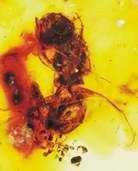Friday, October 27, 2006
Trapped in Amber: Oldest Bee DNA generates a buzz
The discovery of a 100-million-year old bee embedded in amber - perhaps the oldest bee ever found - "pushes the bee fossil record back about 35 million years," according to Bryan Danforth, Cornell associate professor of entomology.
Danforth and George Poinar of Oregon State University found the bee embedded in amber from a mine in northern Myanmar (Burma).
A report [1] on this major fossil discovery, which the researchers say supports a new hypothesis in bee evolution, was published in the October 27 2006 issue of Science.
Scientists have long believed that bees first appeared about 120 million years ago - but previous bee fossil records dated back only about 65 million years. Danforth and Poinar's fossil provides strong evidence for a more remote ancestry. The fact that the bee fossil also has some wasp traits suggests an evolutionary link between wasps and bees.
In a related study [2], published in the October 10 issue of the Proceedings of the National Academy of Sciences, Danforth and several colleagues from other institutions examined early bees' structures in combination with bee DNA, producing the largest molecular and morphological study to date on bee family-level phylogeny - the evolutionary development and diversification of a species. Their goal was to examine the early evolutionary pattern of bees and how their evolution relates to the evolution of flowering plants. Flowering plants are among the most diverse organisms that have ever existed - Charles Darwin called their origin and diversification an "abominable mystery."
More than 16,000 species of bees, organized into seven families, are known to exist. But scientists disagree on which family is the most primitive. Bees are known to affect plant evolution by spreading pollen and preferring to pollinate some types of plants over others. Because scientists assume that bees have essentially always been around, pollinating plants and "creating" new species, it has been a mystery why the bee fossil record only dated back about 65 million years.
Until now, many researchers believed the most primitive bees stemmed from the family Colletidae, which implies that bees originated in the Southern Hemisphere (either South America or Australia). However, the work of Danforth and his group suggests that the earliest branches of the bee's evolutionary tree originate from the family Melittidae. That would mean that bees have an African origin and are almost as old as flowering plants, which would help explain a lot about the evolutionary diversification of these plants.
Source: Cornell University PR "100-million-year-old discovery pushes bees' evolutionary history back 35 million years" November 6 2006
----
[1] Based on the paper:
A Fossil Bee from Early Cretaceous Burmese Amber
G. O. Poinar, Jr. and B. N. Danforth
Science 27 October 2006:
Vol. 314. no. 5799, p. 614
DOI: 10.1126/science.1134103
The bee fossil record is fragmentary, making it difficult to accurately estimate the antiquity of bee-mediated pollination. Here, we describe a bee fossil [Melittosphex burmensis (new species), Melittosphecidae (new family)] from Early Cretaceous Burmese amber (approx 100 million years before the present). The fossil provides insights into the morphology of the earliest bees and provides a new minimum date for the antiquity of bees and bee-mediated pollination.
----
[2] Based on the paper:
The history of early bee diversification based on five genes plus morphology
Bryan N. Danforth, Sedonia Sipes, Jennifer Fang, and Sean G. Brady
Published online before print October 2, 2006, 10.1073/pnas.0604033103
PNAS | October 10, 2006 | vol. 103 | no. 41 | 15118-15123
OPEN ACCESS ARTICLE
Bees, the largest (greater than 16,000 species) and most important radiation of pollinating insects, originated in early to mid-Cretaceous, roughly in synchrony with the angiosperms (flowering plants). Understanding the diversification of the bees and the coevolutionary history of bees and angiosperms requires a well supported phylogeny of bees (as well as angiosperms). We reconstructed a robust phylogeny of bees at the family and subfamily levels using a data set of five genes (4,299 nucleotide sites) plus morphology (109 characters). The molecular data set included protein coding (elongation factor-1{alpha}, RNA polymerase II, and LW rhodopsin), as well as ribosomal (28S and 18S) nuclear gene data. Analyses of both the DNA data set and the DNA+morphology data set by parsimony and Bayesian methods yielded a single well supported family-level tree topology that places Melittidae as a paraphyletic group at the base of the phylogeny of bees. This topology ("Melittidae-LT basal") is significantly better than a previously proposed alternative topology ("Colletidae basal") based both on likelihood and Bayesian methods. Our results have important implications for understanding the early diversification, historical biogeography, host–plant evolution, and fossil record of bees. The earliest branches of bee phylogeny include lineages that are predominantly host–plant specialists, suggesting that host–plant specificity is an ancestral trait in bees. Our results suggest an African origin for bees, because the earliest branches of the tree include predominantly African lineages. These results also help explain the predominance of Melittidae, Apidae, and Megachilidae among the earliest fossil bees.
-------
Related posts include:
"Evolutionary history of vespid wasps rewritten by New study"
"Honeybee : Open Access articles and video from Nature magazine ('Web focus')"
Add to: CiteUlike | Connotea | Del.icio.us | Digg | Furl | Newsvine | Reddit | Yahoo
